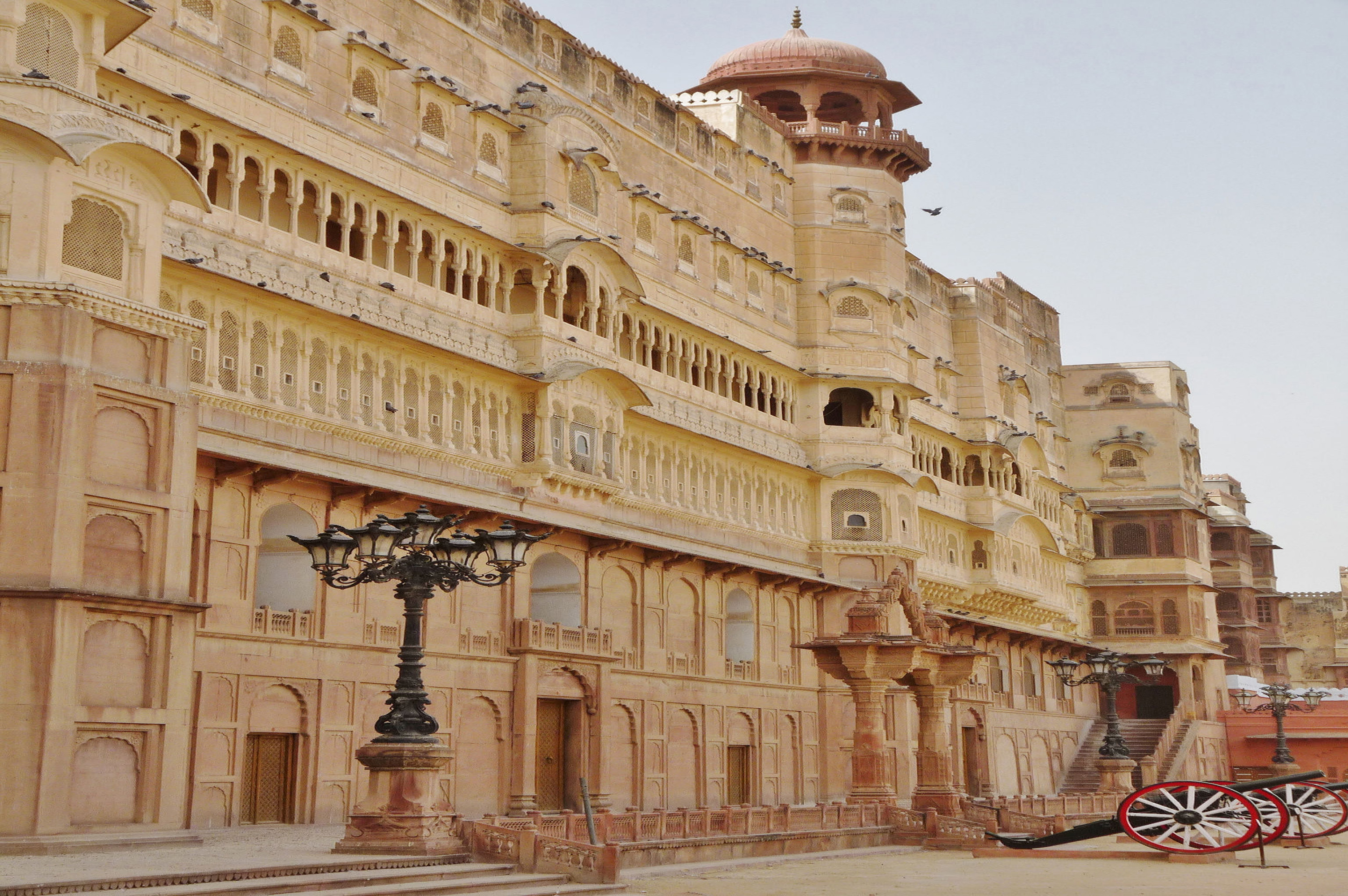
India, a mesmerising world, full of vibrant cultures, traditions and geographies, takes you on a soul stirring journey. It stretches from the snow-capped mountains to the green coastlines, taking you to the depths of spirituality. This entrancing experience is what tourists get when they travel to India. Venture forth and discover this multi-coloured country as it mesmerises you with its raw beauty. And to assist you in this life changing adventure, India travel planner creates an itinerary which incorporates all must visit places, how to reach separately and the best time to visit. Any holiday planned is sure to ensure a lifetime of memories. The wide categories are sure to tempt you to make plans at the earliest.
Forts Of India
Choose Your Next Destination

Mehrangarh Fort, Jodhpur, Rajasthan
Nearest Airport : Jodhpur Mehrangarh or Mehran Fort, located in Jodhpur, Rajasthan, is one of the largest forts in India. Built in around 1459 by Rao Jodha, the fort is situated 410 feet (125 m) above the city and is enclosed by imposing thick walls. Inside its boundaries there are several palaces known for their intricate carvings and expansive courtyards

Red Fort, Delhi
Nearest Airport : New Delhi The Red Fort is a historic fort in the city of Delhi in India. It was the main residence of the emperors of the Mughal dynasty for nearly 200 years, until 1856. it was the ceremonial and political center of the Mughal state and the setting for events critically impacting the region. Constructed in 1639 by the fifth Mughal Emperor Shah Jahan as the palace of his fortified capital Shahjahanabad, the Red Fort is named for its massive enclosing walls of red sandstone and is adjacent to the older Salimgarh Fort, built by Islam Shah Suri in 1546 AD

Gwalior Fort, Gwalior, Madhya Pradesh
Nearest Airport : Jodhpur Mehrangarh or Mehran Fort, located in Jodhpur, Rajasthan, is one of the largest forts in India. Built in around 1459 by Rao Jodha, the fort is situated 410 feet (125 m) above the city and is enclosed by imposing thick walls. Inside its boundaries there are several palaces known for their intricate carvings and expansive courtyards

Golconda Fort, Hyderabad, Andhra Pradesh
Nearest Airport : Gwalior Gwalior Fort is a hill fort near Gwalior, Madhya Pradesh, central India. The fort has existed at least since the 10th century, and the inscriptions and monuments found within what is now the fort campus indicate that it may have existed as early as the beginning of the 6th century. The fort has been controlled by a number of different rulers in its history.

Jaisalmer Fort, Jaisalmer, Rajasthan
Nearest Airport : Hydrabad Golkonda, also known as Golconda, Gol konda ("Round shaped hill"), or Golla konda, (meaning Shepherd's Hill in the regional language telugu) is a citadel and fort in Southern India and was the capital of the medieval sultanate of the Qutb Shahi dynasty (c.1512,1687), is situated 11 km (6.8 mi) west of Hyderabad. It is also a tehsil of Hyderabad district, Telangana, India. The region is known for the mines that have produced some of the world's most famous gems, including the Koh-i-Noor, the Hope Diamond, Nassak Diamond and the Noor-ul-Ain.

Agra Fort, Agra, Uttar Pradesh
Nearest Airport : Jaisalmer Jaisalmer Fort is situated in the city of Jaisalmer, in the Indian state of Rajasthan. It is believed to be one of the very few (perhaps the only) "living forts" in the world, as nearly one fourth of the old city's population still resides within the fort. For the better part of its 800-year history, the fort was the city of Jaisalmer. The first settlements outside the fort walls, to accommodate the growing population of Jaisalmer, are said to have come up in the 17th century.

Kangra Fort, Kangra, Himachal Pradesh
Nearest Airport : New Delhi Distance from Nearest Airport : 220Km Agra Fort is a historical fort in the city of Agra in India. It was the main residence of the emperors of the Mughal Dynasty until 1638, when the capital was shifted from Agra to Delhi. Before capture by the British, the last Indian rulers to have occupied it were the Marathas. In 1983, the Agra fort has been inscribed as UNESCO World Heritage site.It is about 2.5 km northwest of its more famous sister monument, the Taj Mahal. The fort can be more accurately described as a walled city

Chittorgarh Fort, Chittorgarh, Rajasthan
Nearest Airport : Dharamshala Distance from Nearest Airport : 14Km The Kangra Fort was built by the royal Rajput family of Kangra State (the Katoch dynasty), which traces its origins to the ancient Trigarta Kingdom, mentioned in the Mahabharata epic. It is the largest fort in the Himalayas and probably the oldest dated fort in India.At least three rulers sought to conquer the fort and plundered the treasures of its temples: Mahmud Ghazni in 1009, Firuz Shah Tughluq in 1360 and Sher Shah in 1540.The fort of Kangra resisted Akbar's siege. Akbar's son Jahangir successfully subdued the fort in 1620.Kangra was at the time ruled by Raja Hari Chand Katoch of Kangra (also known as Raja Hari Chand II)[3] Mughal Emperor Jahangir with the help of Suraj Mal garrisoned with his troops

Panhala Fort, Kolhapur, Maharashtra
Nearest Airport : Udaipur Distance from Nearest Airport : 96Km The Chittor Fort or Chittorgarh is one of the largest forts in India. It is a UNESCO World Heritage Site. The fort was the capital of Mewar and is located in the present-day town of Chittor. It sprawls over a hill 180 m (590.6 ft) in height spread over an area of 280 ha (691.9 acres) above the plains of the valley drained by the Berach River. The fort precinct has several historical palaces, gates, temples and two prominent commemorative towers

Srirangapatnam Fort, Srirangapatnam, Karnataka
Nearest Airport : Kolahpur Panhala fort (also known as Panhalgad, Pahalla and Panalla (literally "the home of serpents"), is located in Panhala, 20 kilometres northwest of Kolhapur in Maharashtra, India. It is strategically located looking over a pass in the Sahyadri mountain range which was a major trade route from Bijapur in the interior of Maharashtra to the coastal areas.Due to its strategic location, it was the centre of several skirmishes in the Deccan involving the Marathas, the Mughals and the British East India Company, the most notable being the Battle of Pavan Khind. Here, the queen regent of Kolhapur State, Tarabai, spent her formative years

Amber Fort, Jaipur, Rajasthan
Nearest Airport : Mysore Distance from Nearest Airport : 16Km Srirangapatna Fort is a historical fort located in Srirangapatna, the historical capital city in the South Indian state of Karnataka. Built by the Timmanna Nayaka in 1454, the fort came to prominence during the rule of Tipu Sultan. The fort was fully fortified and the architecture was modified with the help of French architects to meet the growing needs of saving against invaders. The river Kaveri surrounds the fort in one of the sides. The fort is protected in the West and Northern directions by river Cauvery. The fort had Lal Mahal and Tipu's palace, which were demolished during the British capture of 1799. There are seven outlets and two dungeons.

Daulatabad Fort, Aurangabad, Maharashtra
Nearest Airport : Jaipur Amer Fort is a fort located in Amer, Rajasthan, India. Amer is a town with an area of 4 square kilometres (1.5 sq mi) located 11 kilometres (6.8 mi) from Jaipur, the capital of Rajasthan. Located high on a hill, it is the principal tourist attraction in Jaipur.[2][3] The town of Amer was originally built by Meenas,[4] and later it was ruled by Raja Man Singh I. Amer Fort is known for its artistic style elements. With its large ramparts and series of gates and cobbled paths, the fort overlooks Maota Lake,[3][5][6][7] which is the main source of water for the Amer Palace.

Junagarh Fort, Bikaner, Rajasthan
Nearest Airport : Aurangabad Daulatabad, also known as Devagiri, is a 14th-century fort city in Maharashtra state of India, about 16 kilometres (9.9 mi) northwest of Aurangabad. The place was originally named Devagiri when it was an important uplands city along caravan routes (ca. sixth century AD), but the intervening centuries have reduced it to a village. The historical triangular fort of Daulatabad was built by first Yadava king Bhillama V in 1187.Starting 1327, it famously remained the capital of Tughlaq dynasty, under Muhammad bin Tughluq (r. 1325-1351), who also changed its name, and forcibly moved the entire population of Delhi for two years before it was abandoned for lack of water and Tughluq was constantly known to shift the capital from Delhi to Daulatabad and Daulatabad to Delhi.

Jhansi Fort, Jhansi, Madhya Pradesh
Nearest Airport : Jodhpur Distance from Nearest Airport : 251Km Junagarh Fort is a fort in the city of Bikaner, Rajasthan, India. The fort was originally called Chintamani and was renamed Junagarh or "Old Fort" in the early 20th century when the ruling family moved to Lalgarh Palace outside the fort limits. It is one of the few major forts in Rajasthan which is not built on a hilltop. The modern city of Bikaner has developed around the fort. The fort complex was built under the supervision of Karan Chand, the Prime Minister of Raja Rai Singh the sixth ruler of Bikaner, who ruled from 1571 to 1611 AD. Construction of the walls and associated moat commenced in 1589 and was completed in 1594. It was built outside the original fort of the city, about 1.5 kilometres (0.93 mi) from the city centre. Some remnants of the old fort are preserved near the Lakshmi Narayan temple

Jaigarh Fort, Jaipur, Rajasthan
Nearest Airport : Gwalior Distance from Nearest Airport : 97Km Jhansi Fort or Jhansi ka Kila is a fortress situated on a large hilltop called Bangira, in Uttar Pradesh, Northern India. It served as a stronghold of the Chandela Kings in Balwant Nagar from the 11th through the 17th century. The construction of the Jhansi fort is ascribed to the Bundela Rajput chief and the ruler of the kingdom of Orchha Veer Singh ju Deo Bundela in 1613.It is one of the strongholds of the Bundelas. In 1728.
